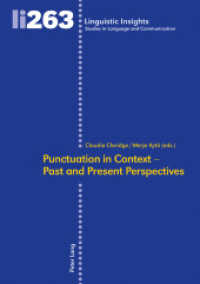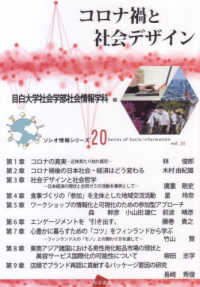- ホーム
- > 洋書
- > 英文書
- > Science / Mathematics
Full Description
Nanotechnologies represent a fast-growing market and this unique volume highlights the current studies in applied sciences on sustainability of green science and technology. The chapters include modelling, machine learning, nanotechnology, nanofluids, nanosystems, smart materials and applications and solar and fuel cells technology. The authors cover simulation, additive manufacturing, machine learning and the autonomous system. Various aspects of green science as well as trans-disciplinary topics between fundamental science and engineering are presented.The book is suitable for all postgraduates and researchers working in this rapid growing research area.
Features
Presenting latest research on green materials and sustainability.
Provide in depth discussion on modeling and simulation using latest techniques.
Technical exposure for the readers on additive manufacturing principles.
Numerous examples on nanofluids and nano technology are presented.
Discusses computer modeling, superconductivity, nanotubes and related structures such as graphene.
Contents
Chapter 1 Introduction
Chapter 2 Phase Identification, Morphology, and Compressibility of Scallop Shell Powder (Amusium Pleuronectes) for Bone Implant Materials
Chapter 3 High Pressure Die Casting Simulation for Oil Pan Production against Its Porosity, Shrinkage, and Niyama Criterion
Chapter 4 Thermophysical Properties of Nanolubricant SAE 5W-30 with additional Al2O3, TiO2, and Hybrid Al2O3-TiO2 for Motorcycle Performance
Chapter 5 Heat Transfer Performance of Water, Ethylene Glycol and Water-Ethylene Glycol as Base Fluid Dispersed by TiO2 Nanoparticle: CFD Modelling on Double Pipe Heat Exchanger
Chapter 6 Microstructure Change of Aluminum 6061 on Natural and Artificial Aging
Chapter 7 Characterisation of self-healing concrete incorporating plastic waste as partial material substitution
Chapter 8 Graded concrete: Towards eco-friendly construction by material optimization
Chapter 9 Performance of surgical blades from biocompatible bulk metallic glasses and metallic glass thin films for sustainable medical devices improvement
Chapter 10 Synthesis and Characterization of Zinc Ferrite as Nanofluid Heat Exchanger Deploying Co-Precipitation Method
Chapter 11 A Study of Risk Assessment in The Nanomaterials Laboratory of Mechanical Engineering Department and The Materials Physics Laboratory Of Department Of Physics At State University Of Malang
Chapter 12 Fabrication and Characterization of Dye Sensitized Solar Cell in Various Metal Oxide Structure
Chapter 13 Characterizations of Amino-Functionalized Metal-Organic Framework Loaded with Imidazole
Chapter 14 Green removal of Bisphenol A (BPA) from aqueous media using Zr-based metal-organic frameworks (MOF)






